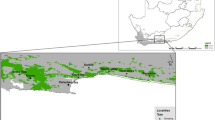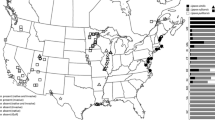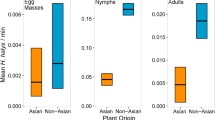Abstract
The accidental introduction of the spiralling whitefly, Aleurodicus dispersus Russell (Homoptera: Aleyrodidae) to Seychelles in late 2003 is exploited during early 2005 to study interactions between A. dispersus, native and exotic host plants and their associated arthropod fauna. The numbers of A. dispersus egg spirals and pupae, predator and herbivore taxa were recorded for eight related native/exotic pairs of host plants found on Mahé, the largest island in Seychelles. Our data revealed no significant difference in herbivore density (excluding A. dispersus) between related native and exotic plants, which suggests that the exotic plants do not benefit from ‘enemy release’. There were also no differences in predator density, or combined species richness between native and exotic plants. Together these data suggest that ‘biotic resistance’ to invasion is also unlikely. Despite the apparent lack of differences in community structure significantly fewer A. dispersus egg spirals and pupae were found on the native plants than on the exotic plants. Additional data on A. dispersus density were collected on Cousin Island, a managed nature reserve in which exotic plants are carefully controlled. Significantly higher densities of A. dispersus were observed on Mahé, where exotic plants are abundant, than on Cousin. These data suggest that the rapid invasion of Seychelles by A. dispersus may largely be due to the high proportion of plant species that are both exotic and hosts of A. dispersus; no support was found for either the ‘enemy release’ or the ‘biotic resistance’ hypotheses.






Similar content being viewed by others
References
Agrawal AA, Kotanen PM et al (2005) Enemy release? An experiment with congeneric plant pairs and diverse above- and belowground enemies. Ecology 86:2979–2989
Anderson JE, Inouye RS (2001) Landscape-scale changes in plant species abundance and biodiversity of a sagebrush steppe over 45 years. Ecol Monogr 71:531–556
Bakker JD, Wilson SD (2004) Using ecological restoration to constrain biological invasion. J Appl Ecol 41:1058–1064
Baltz DM, Moyle PB (1993) Invasion resistance to introduced species by a native assemblage of California stream fishes. Ecol Appl 3:246–255
Bezemer TM, van Dam NM (2005) Linking aboveground and belowground interactions via induced plant defenses. Trends Ecol Evol 20:617–624
Bezemer TM, De Deyn GB et al (2005) Soil community composition drives aboveground plant-herbivore-parasitoid interactions. Ecol Lett 8:652–661
Christian JM, Wilson SD (1999) Long-term ecosystem impacts of an introduced grass in the northern Great Plains. Ecology 80:2397–2407
Colautti RI, Ricciardi A et al (2004) Is invasion success explained by the enemy release hypothesis? Ecol Lett 7:721–733
Colautti RI, Bailey SA et al (2006) Characterised and projected costs of nonindigenous species in Canada. Biol Invasions 8:45–59
Crosby AW (1986) Ecological imperialism. The biological expansion of Europe, 900–1900. Cambridge University Press, Cambridge
D’Almeida YA, Lys JA et al (1998) Impact of two accidentally introduced Encarsia species (Hymenoptera: Aphelinidae) and other biotic and abiotic factors on the spiralling whitefly Aleurodicus dispersus (Russell) (Homoptera: Aleyrodidae), in Benin, West Africa. Biocontrol Sci Technol 8:163–173
De Rivera CE, Ruiz GM et al (2005) Biotic resistance to invasion: native predator limits abundance and distribution of an introduced crab. Ecology 86:3364–3376
Elton CS (1958) The ecology of invasions by plants and animals. Meuthen, London
Geetha B (2000) Biology and management of spiralling whitefly Aleurodicus dispersus Russell (Homoptera: Aleyrodidae). Ph.D. thesis, Tamil Nadu Agricultural University, India
Harvey BC, White JL et al (2004) An emergent multiple predator effect may enhance biotic resistance in a stream fish assemblage. Ecology 85:127–133
Heidinga L, Wilson SD (2002) The impact of an invading alien grass (Agropyron cristatum) on species turnover in native prairie. Divers Dist 8:249–258
Keane RM, Crawley MJ (2002) Exotic plant invasions and the enemy release hypothesis. Trends Ecol Evol 17:164–169
Kumashiro BR, Lai PY et al (1983) Efficacy of Nephaspis amnicola and Encarsia ?haitiensis in controlling Aleurodicus dispersus in Hawaii. Proc Hawaiian Entomol Soc 24:261–269
Kushner RB, Hovel KA (2006) Effects of native predators and eelgrass habitat structure on the introduced Asian mussel Musculista senhousia (Benson in Cantor) in southern California. J Exp Marine Biol Ecol 332:166–177
Levine JM, Adler PB et al (2004) A meta-analysis of biotic resistance to exotic plant invasions. Ecol Lett 7:975–989
Louda SM, Pemberton RW et al (2003) Non-target effects—the Achilles heel of biological control? Retrospective analyses to reduce risk associated with biocontrol introductions. Ann Rev Entomol 48:365–396
Mack RN, Simberloff D et al (2000) Biotic invasions: causes, epidemiology, global consequences, and control. Ecol Appl 10:689–710
Mani M, Krishnamoorthy A et al (2004) Role of the aphelinid parasitoid Encarsia guadeloupae in the suppression of the exotic spiralling whitefly Aleurodicus dispersus on banana in India. Biocontrol Sci Technol 14:619–622
Mitchell CE, Power AG (2003) Release of invasive plants from fungal and viral pathogens. Nature 421:625–627
Neuenschwander P (1996) Evaluating the efficacy of biological control of three exotic homopteran pests in tropical Africa. Entomophaga 41:405–424
Ohgushi T (2005) Indirect interaction webs: herbivore-induced effects through trait change in plants. Ann Rev Ecol Evol Syst 36:81–105
Parker JD, Burkepile DE et al (2006) Opposing effects of native and exotic herbivores on plant invasions. Science 311:1459–1461
Pimentel D, Zuniga R et al (2005) Update on the environmental and economic costs associated with alien-invasive species in the United States. Ecol Econ 52:273–288
Ramani S (2000) Fortuitous introduction of an aphelinid parasitoid of the spiralling whitefly, Aleurodicus dispersus Russell (Homoptera: Aleyrodidae) into the Lakshadweep islands, with notes on host plants and other natural enemies. J Biol Cont 14:55–60
Ramani S, Poorani J et al (2002) Spiralling whitefly, Aleurodicus dispersus, in India. Biocontrol News Inf 23:55N–62N
Robertson SA (1989) Flowering plants of Seychelles. Royal Botanic Gardens, Kew
Russell LM (1965) A new species of Aleurodicus Douglas and two close relatives. Fla Entomol 48:47–55
Scoppettone GG, Rissler PH et al (2005) Habitat restoration as a means of controlling non-native fish in a Mojave Desert oasis. Restor Ecol 13:247–256
Simberloff D, Von Holle B (1999) Positive interactions of nonindigenous species: invasional meltdown? Biol invasions 1:21–32
Soler R, Bezemer TM et al (2005) Root herbivore effects on above-ground herbivore, parasitoid and hyperparasitoid performance via changes in plant quality. J Anim Ecol 74:1121–1130
StatSoft, Inc (1998) STATISTICA for Windows [Computer program manual]. Tulsa, OK
van Ruijven J, De Deyn GB et al (2005) Interactions between spatially separated herbivores indirectly alter plant diversity. Ecol Lett 8:30–37
Waterhouse DF, Norris KR (1989) Biological control: pacific prospects—supplement 1. ACIAR, ACIAR Monograph No.12, Canberra, Australia
Wen HC, Tung CH et al (1995) Yield loss and control of spiralling whitefly (Aleurodicus dispersus Russell). J Agric Res China 44:147–156
Wilcove DS, Rothstein D et al (1998) Quantifying threats to imperiled species in the United States. Bioscience 48:607–615
Acknowledgements
SPH was supported by the World Bank/GEF medium sized project grant ‘Improving the management of NGO- and privately-managed nature reserves and islands of high biodiversity value in Seychelles’ awarded to Nature Seychelles. Thanks also to the staff of Nature Seychelles for logistical support and advice, particularly Nimral Shah, James Hardcastle, Rachel Bristol, Conor Jamison, Alex Underwood and Ian Valois and to Tim Blackburn for commenting on an earlier version of this manuscript.
Author information
Authors and Affiliations
Corresponding author
Rights and permissions
About this article
Cite this article
Hazell, S.P., Vel, T. & Fellowes, M.D.E. The role of exotic plants in the invasion of Seychelles by the polyphagous insect Aleurodicus dispersus: a phylogenetically controlled analysis. Biol Invasions 10, 169–175 (2008). https://doi.org/10.1007/s10530-007-9120-2
Received:
Accepted:
Published:
Issue Date:
DOI: https://doi.org/10.1007/s10530-007-9120-2




